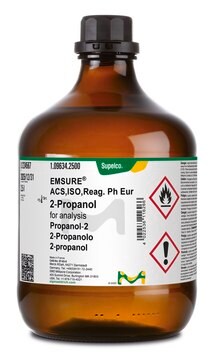Key Documents
320048
2-Methyl-1-propanol
ACS reagent, ≥99.0%
Synonim(y):
Isobutanol, Isobutyl alcohol
About This Item
Polecane produkty
klasa czystości
ACS reagent
Poziom jakości
gęstość pary
2.55 (vs air)
ciśnienie pary
8 mmHg ( 20 °C)
8.8 mmHg ( 0 °C)
Próba
≥99.0%
Postać
liquid
temp. samozapłonu
801 °F
granice wybuchowości
10.6 %
zanieczyszczenia
≤0.0005 meq/g Titr. acid
≤0.01% butyraldehyde
≤0.02% 2-butanone
≤0.1% water
pozostałość po odparowaniu
≤0.001%
kolor
APHA: ≤10
współczynnik refrakcji
n20/D 1.396 (lit.)
tw
108 °C (lit.)
mp
−108 °C (lit.)
gęstość
0.803 g/mL at 25 °C (lit.)
ciąg SMILES
CC(C)CO
InChI
1S/C4H10O/c1-4(2)3-5/h4-5H,3H2,1-2H3
Klucz InChI
ZXEKIIBDNHEJCQ-UHFFFAOYSA-N
Szukasz podobnych produktów? Odwiedź Przewodnik dotyczący porównywania produktów
Powiązane kategorie
Hasło ostrzegawcze
Danger
Zwroty wskazujące rodzaj zagrożenia
Zwroty wskazujące środki ostrożności
Klasyfikacja zagrożeń
Eye Dam. 1 - Flam. Liq. 3 - Skin Irrit. 2 - STOT SE 3
Organy docelowe
Central nervous system, Respiratory system
Kod klasy składowania
3 - Flammable liquids
Klasa zagrożenia wodnego (WGK)
WGK 1
Temperatura zapłonu (°F)
82.4 °F - closed cup
Temperatura zapłonu (°C)
28 °C - closed cup
Certyfikaty analizy (CoA)
Poszukaj Certyfikaty analizy (CoA), wpisując numer partii/serii produktów. Numery serii i partii można znaleźć na etykiecie produktu po słowach „seria” lub „partia”.
Masz już ten produkt?
Dokumenty związane z niedawno zakupionymi produktami zostały zamieszczone w Bibliotece dokumentów.
Klienci oglądali również te produkty
Nasz zespół naukowców ma doświadczenie we wszystkich obszarach badań, w tym w naukach przyrodniczych, materiałoznawstwie, syntezie chemicznej, chromatografii, analityce i wielu innych dziedzinach.
Skontaktuj się z zespołem ds. pomocy technicznej












